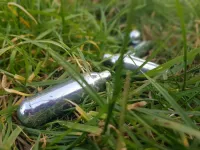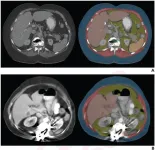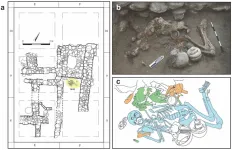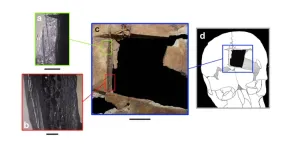(Press-News.org) VIDEOS: Interviews, B-Roll
https://www.dropbox.com/scl/fo/b1tpiamgunp5ekymyxaks/h?dl=0&rlkey=zk15bee6kru69ebryxaha0g3j
YouTube Video. Unlisted & only viewable w/ link until embargo lifts. https://youtu.be/Ceg7R3sw7Qs
Patients with Parkinson’s disease achieved a significant improvement in their tremors, mobility, and other physical symptoms after having a minimally invasive procedure involving focused ultrasound, according to a new study today published in the New England Journal of Medicine.
The clinical trial was led by researchers at the University of Maryland School of Medicine (UMSOM) and involved 94 Parkinson’s disease patients who were randomly assigned to undergo focused ultrasound to ablate a targeted region on one side of the brain or to have a sham procedure. Nearly 70 percent of patients in the treatment group were considered successful responders to treatment after three months of follow-up, compared to 32 percent in the control group who had an inactive procedure without focused ultrasound.
Two-thirds of those who responded initially to the focused ultrasound treatment continued to have a successful response from the treatment a year later.
Patients were treated at the University of Maryland Medical Center (UMMC), the academic flagship hospital for the University of Maryland Medical System, and 15 other sites in North America, Asia, and Europe.
“These results are very promising and offer Parkinson’s disease patients a new form of therapy to manage their symptoms. There is no incision involved, which means no risk of a serious infection or brain bleeding,” said study corresponding author Howard Eisenberg, MD, the Raymond K. Thompson Professor of Neurosurgery at UMSOM and a neurosurgeon at UMMC.
About one million Americans have Parkinson’s disease, a neurodegenerative disorder that affects brain cells or neurons in a specific area of the brain that produce the brain chemical dopamine. Symptoms include shaking, stiffness, and difficulty with balance and coordination. Other treatments for Parkinson’s include medications and deep brain stimulation (DBS) from surgically implanted electrodes. The medications can cause involuntary, erratic movements called dyskinesia as doses are increased to control symptoms. Usually offered when medications fail, DBS involves brain surgery to insert the electrodes through two small openings in the skull. The procedure carries a small risk of serious side effects including brain hemorrhage and infection.
“Our study will help doctors and patients make an informed decision when considering this new treatment modality to help better manage symptoms,” said study co-author Paul Fishman, MD, PhD, Professor of Neurology at UMSOM and a neurologist at UMMC. “But it’s important for patients to realize that none of the treatments currently available will cure Parkinson’s disease.”
Focused ultrasound is an incisionless procedure, performed without the need for anesthesia or an in-patient stay in the hospital. Patients, who remain fully alert, lie in a magnetic resonance imaging (MRI) scanner, wearing a transducer helmet. Ultrasonic energy is targeted through the skull to the globus pallidus, a structure deep in the brain that helps control regular voluntary movement. MRI images provide doctors with a real-time temperature map of the area being treated, to precisely pinpoint the target and to apply a high enough temperature to ablate it. During the procedure, the patient is awake and providing feedback, which allows doctors to monitor the immediate effects of the tissue ablation and make adjustments as needed.
The device, called Exablate Neuro, was approved over a year ago by the US Food and Drug Administration (FDA) to treat advanced Parkinson’s disease on one side of the brain. The FDA approval was based on findings from the UMSOM clinical trial published today. The procedure is now widely available at the University of Maryland Medical Center (UMMC). However, it is not yet covered by insurance, including Medicare, so patients currently need to pay out of pocket for the procedure.
“Focused ultrasound is only approved by the FDA to treat one side of the brain in Parkinson’s disease patients, so it may be more appropriate at this time for patients with symptoms predominantly on one side,” said study co-author Vibhor Krishna, MD, a professor of neurosurgery at the University of North Carolina, Chapel Hill.
Diagnosed with Parkinson’s disease in 2020, Melanie Carlson, a 41-year-old mother of a toddler, found that the medications she was taking to manage the condition caused her to have uncontrollable shaking. Her symptoms were so severe, she was dependent on a walker and unable to take her daughter to the playground. Last June, she opted to have focused ultrasound at UMMC after learning about the FDA approval.
“Focused ultrasound was really transformative. So many of my fine motor skills have returned. I’m putting on eyeliner again and taking showers again without falling,” Carlson said. “This honestly feels like one of the best years of my life. I just feel so fortunate. I hope more people can benefit from this procedure.”
Patients enrolled in the trial -- with moderate Parkinson’s who were not responding well to medications -- were treated with one session of focused ultrasound on the side of their brain that controlled the side of their body where symptoms were more severe. The study was designed as a crossover trial, where 25 patients in the control group were offered the active treatment three months after their sham procedure; 20 out of 25 opted to have the focused-ultrasound treatment and experienced similar benefits as the initial treatment group.
Those in the treatment group had an immediate improvement of at least three points on a standard assessment -- measuring tremors, walking abilities, and rigidity in the legs and arms -- compared to an 0.3 point improvement in the control group. They also experienced relief from side effects from Parkinson’s medications. They were assessed again at three months and at 12 months. Patients will continue to be followed for five years to evaluate how long the treatment lasts and progression of the disease.
Adverse events from the procedure included headache, dizziness, and nausea that resolved within a day or two of treatment. Some patients experienced mild side effects from the focused ultrasound treatment, including slurred speech, walking issues, and loss of taste. These usually resolved within the first few weeks.
Dr. Eisenberg and his colleagues are currently conducting a clinical trial to test the Exablate Neuro device on both sides of the brain, delivering focused ultrasound treatments in two sessions, six months apart. “So far, we’ve had promising results,” Dr. Eisenberg said.
The study was funded by Insightec, manufacturer of Exablate Neuro.
“We are on the edge of the frontier with focused ultrasound, as ongoing research evaluates the procedure in different brain areas affected by Parkinson’s, such as the subthalamic nucleus, which controls movement regulation,” said UMSOM Dean, Mark T. Gladwin, MD, who is also Vice President for Medical Affairs, University of Maryland, Baltimore, and the John Z. and Akiko K. Bowers Distinguished Professor. “Researchers also are studying how focused ultrasound could be used to temporarily open the blood-brain barrier to help experimental Parkinson’s treatments, like immunotherapy, get into the brain more easily.”
“As home to one of the top movement disorder centers in the country, and one of only a few medical centers that offer focused ultrasound for Parkinson’s, we see firsthand the technology’s impact on people’s lives. Congratulations to the researchers—and the trial participants—for exemplifying the innovation and discovery that will make focused ultrasound available to more people in the years to come,” said Bert W. O'Malley, MD, President and CEO of UMMC.
About the University of Maryland School of Medicine
Now in its third century, the University of Maryland School of Medicine was chartered in 1807 as the first public medical school in the United States. It continues today as one of the fastest growing, top-tier biomedical research enterprises in the world -- with 46 academic departments, centers, institutes, and programs, and a faculty of more than 3,000 physicians, scientists, and allied health professionals, including members of the National Academy of Medicine and the National Academy of Sciences, and a distinguished two-time winner of the Albert E. Lasker Award in Medical Research. With an operating budget of more than $1.3 billion, the School of Medicine works closely in partnership with the University of Maryland Medical Center and Medical System to provide research-intensive, academic, and clinically based care for nearly 2 million patients each year. The School of Medicine has nearly $600 million in extramural funding, with most of its academic departments highly ranked among all medical schools in the nation in research funding. As one of the seven professional schools that make up the University of Maryland, Baltimore campus, the School of Medicine has a total population of nearly 9,000 faculty and staff, including 2,500 students, trainees, residents, and fellows. The combined School of Medicine and Medical System (“University of Maryland Medicine”) has an annual budget of over $6 billion and an economic impact of nearly $20 billion on the state and local community. The School of Medicine, which ranks as the 8th highest among public medical schools in research productivity (according to the Association of American Medical Colleges profile) is an innovator in translational medicine, with 606 active patents and 52 start-up companies. In the latest U.S. News & World Report ranking of the Best Medical Schools, published in 2021, the UM School of Medicine is ranked #9 among the 92 public medical schools in the U.S., and in the top 15 percent (#27) of all 192 public and private U.S. medical schools. The School of Medicine works locally, nationally, and globally, with research and treatment facilities in 36 countries around the world. Visit medschool.umaryland.edu
END
Parkinson’s disease patients experience significant reduction in symptoms with non-surgical focused ultrasound treatment
Study led to FDA approval of focused ultrasound device that provides novel treatment option without requiring incision
2023-02-23
ELSE PRESS RELEASES FROM THIS DATE:
UTA research explores how T-cells detect cancer
2023-02-23
A University of Texas at Arlington bioengineering professor is leading a state-funded project that will try to identify what T-cells are detecting in cancerous cells to better craft a personalized cancer immunotherapy.
George Alexandrakis received a $250,000 Cancer Prevention and Research Institute of Texas (CPRIT) grant titled “Ultrasensitive Nanosensor-Based Detection of Tumor Immunogenic Peptides to Enable Personalized Cancer Immunotherapy.”
“One of the challenges with cancer is that it is so variable. It changes all the time and is different in all people,” Alexandrakis said. ...
After 25 years of AI health tech research computers are slowly beginning to listen to patients
2023-02-23
Patients experiences of health conditions are slowly being integrated into healthcare AI studies, a review of 25 years of studies has found.
In a new paper published in Lancet Digital Health along with an associated opinion piece, experts from the University of Birmingham and University Hospitals Birmingham have looked at more than 600 interventional studies on AI healthcare technologies.
While the team, funded by the National Institute for Health and Care Research (NIHR), found that only 24% of studies have a patient reported outcome element included in their study, there has been an increase in the number in recent years with 2021 and 2022 seeing nearly two thirds of all studies ...
Prioritise tackling toxic emissions from tyres, urge Imperial experts
2023-02-23
Imperial experts are calling for more to be done to limit the potentially harmful impact of toxic tyre particles on health and the environment.
The researchers, from Imperial College London’s Transition to Zero Pollution initiative, warn that even though electric vehicles remove the problem of fuel emissions, we will continue to have a problem with particulate matter because of tyre wear.
Six million tonnes of tyre wear particles are released globally each year, and in London alone, 2.6 million vehicles emit around nine thousand tonnes of tyre wear particles annually.
Despite this, research on the environmental ...
Surge in nitrous oxide abuse: New guidelines to help clinicians recognise cases and prevent spinal cord damage
2023-02-23
Recommendations from research published today on the diagnosis and treatment of spinal cord damage caused by nitrous oxide abuse have been simultaneously adopted as official clinical practice guidelines by the Association of British Neurologists. The unprecedented speed in translating research into practice is necessary as medical cases of nitrous oxide abuse surge in parallel with increased use of what is now the second most popular recreational drug among young people in the UK.
Recreational use of nitrous oxide (N2O - also known as laughing gas) ...
Technical adequacy of artificial intelligence body composition assessed in external CT
2023-02-23
Leesburg, VA, February 23, 2023—According to an accepted manuscript published in ARRS’ American Journal of Roentgenology (AJR), certain reasons for AI tool failure relating to technical factors may be largely preventable through proper acquisition and reconstruction protocols.
“The automated AI body composition tools had high technical adequacy rates in a heterogeneous sample of external CT examinations, supporting the tools’ generalizability and potential for broad use,” concluded head researcher B. Dustin Pooler, MD, from the University of ...
New predatory fish species which lived about 360 million years ago may have grown to over 2.5m long, according to analysis of South African fossils
2023-02-22
New predatory fish species which lived about 360 million years ago may have grown to over 2.5m long, according to analysis of South African fossils
###
Article URL: https://journals.plos.org/plosone/article?id=10.1371/journal.pone.0281333
Article Title: A high latitude Gondwanan species of the Late Devonian tristichopterid Hyneria (Osteichthyes: Sarcopterygii)
Author Countries: South Africa, Sweden
Funding: PEA: Wallenberg Scholarship (not numbered), from the Knut & Alice Wallenberg Foundation. https://kaw.wallenberg.org PEA: ERC Advanced ...
Influence of US weather conditions on tornado trends since 1980 explored by new model
2023-02-22
Influence of US weather conditions on tornado trends since 1980 explored by new model
###
Article URL: https://journals.plos.org/plosone/article?id=10.1371/journal.pone.0281312
Article Title: Long term temporal trends in synoptic-scale weather conditions favoring significant tornado occurrence over the central United States
Author Countries: USA
Funding: The authors received no specific funding for this work. END ...
Cash transfers in LMICs may help alleviate depression and anxiety symptoms - especially if such transfers are unconditional
2023-02-22
Cash transfers in LMICs may help alleviate depression and anxiety symptoms - especially if such transfers are unconditional
###
Article URL: https://journals.plos.org/plosone/article?id=10.1371/journal.pone.0281283
Article Title: Do cash transfers alleviate common mental disorders in low- and middle-income countries? A systematic review and meta-analysis
Author Countries: UK, Germany
Funding: JS was supported by the Joachim Herz Foundation (https://www.joachim-herz-stiftung.de/en/). AR received funding from the Wellcome Trust (220206/Z/20/Z, ...
Two high status brothers had access to “brain surgery” in Bronze Age Israel
2023-02-22
Two high status brothers buried in a Bronze Age tomb in Israel were severely ill but apparently had access to rare treatments including trephination, according to a study published February 22, 2023 in the open-access journal PLOS ONE by Rachel Kalisher of Brown University, Rhode Island, and colleagues.
In this study, authors examined the remains of two individuals buried in a tomb beneath an elite residence in the archaeological site of Tel Megiddo in Israel. The tomb dates to the Late Bronze Age (around 1550-1450 BC), and DNA testing suggests the buried individuals are brothers. Both skeletons show evidence of disease, providing an opportunity ...
Archaeologists uncover early evidence of brain surgery in Ancient Near East
2023-02-22
PROVIDENCE, R.I. [Brown University] — Archaeologists know that people have practiced cranial trephination, a medical procedure that involves cutting a hole in the skull, for thousands of years. They’ve turned up evidence that ancient civilizations across the globe, from South America to Africa and beyond, performed the surgery.
Now, thanks to a recent excavation at the ancient city of Megiddo, Israel, there’s new evidence that one particular type of trephination dates back to at least the late Bronze Age.
Rachel Kalisher, a Ph.D. candidate at Brown University’s Joukowsky ...
LAST 30 PRESS RELEASES:
Scalable and healable gradient textiles for multi‑scenario radiative cooling via bicomponent blow spinning
Research shows informed traders never let a good climate crisis go to waste
Intelligent XGBoost framework enhances asphalt pavement skid resistance assessment
Dual-function biomaterials for postoperative osteosarcoma: Tumor suppression and bone regeneration
New framework reveals where transport emissions concentrate in Singapore
NTP-enhanced lattice oxygen activation in Ce-Co catalysts for low-temperature soot combustion
Synergistic interface engineering in Cu-Zn-Ce catalysts for efficient CO2 hydrogenation to methanol
COVID-19 leaves a lasting mark on the human brain
Scientists use ultrasound to soften and treat cancer tumors without damaging healthy tissue
Community swimming program for Black youth boosts skills, sense of belonging, study finds
Specific depressive symptoms in midlife linked to increased dementia risk
An ‘illuminating’ design sheds light on cholesterol
Who is more likely to get long COVID?
Study showcases resilience and rapid growth of “living rocks”
Naval Research Lab diver earns Office of Naval Research 2025 Sailor of the Year
New Mayo-led study establishes practical definition for rapidly progressive dementia
Fossil fuel industry’s “climate false solutions” reinforce its power and aggravate environmental injustice
Researchers reveal bias in a widely used measure of algorithm performance
Alcohol causes cancer. A study from IOCB Prague confirms damage to DNA and shows how cells defend against it
Hidden viruses in wastewater treatment may shape public health risks, study finds
Unlock the power of nature: how biomass can transform climate mitigation
Biochar reshapes hidden soil microbes that capture carbon dioxide in farmland
Reducing saturated fat intake shows mortality benefit, but only in high-risk individuals
Manta rays create mobile ecosystems, study finds
Study: Mixed results in using lipoic acid to treat progressive multiple sclerosis
Norbert Holtkamp appointed director of Fermi National Accelerator Laboratory
New agentic AI platform accelerates advanced optics design
Biologists discover neurons use physical signals — not electricity — to stabilize communication
Researchers discover that a hormone can access the brain by hitchhiking
University of Oklahoma researcher awarded funding to pursue AI-powered material design
[Press-News.org] Parkinson’s disease patients experience significant reduction in symptoms with non-surgical focused ultrasound treatmentStudy led to FDA approval of focused ultrasound device that provides novel treatment option without requiring incision







